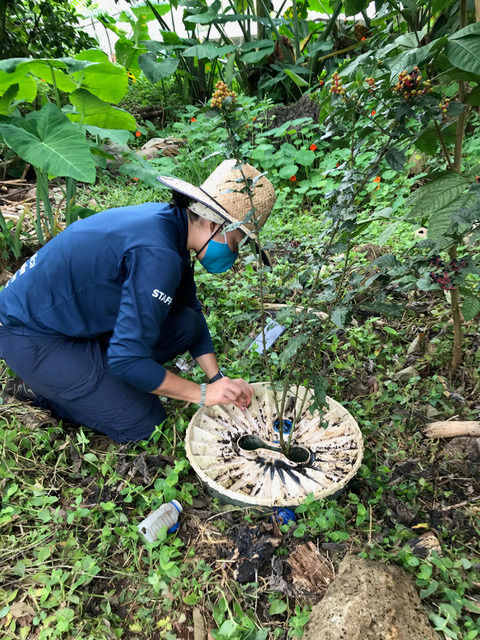This page is the photo supplement to the article published in
the Summer 2022 edition of El Tecolote
The Galapagos Verde 2050 crew—the program does scientific experiments in habitat restoration and endangered plant species recovery to aid in conservation and restoration of degraded habitats in the Galapagos Islands National Park. Most are Ecuadorian.

Darlene with Charles Darwin on the Charles Darwin Research Station

View of Darwin finch from my office window drinking from the air conditioner outflow.

Lily monitoring native plant installed on a local farm, with Waterboxx to conserve water for plant establishment.

Lava Heron with Sally Lightfoot crabs.

Local resident waiting for the bus (sea lion). People are required to stay 6 feet away from wildlife.

Endemic shrub Scalesia affinis grew mostly where the town of Puerto Ayora is located, and is now listed as “vulnerable.” Galapagos Verde has planted many in ecological gardens around the town, and is now growing plants to give to residents for home gardens. The common name is “lechoso de lava”; lechoso means milky in Spanish, for the milky sap. Pavel and I are planting seeds.



Brown Pelican in Mangroves, Puerto Ayora

American Flamingo, Rabida

Kayaking, Playa el Garrapatero

Monitoring the endangered plant Lecocarpus lecocarpoides in the lab, grown from seeds collected on Española Island.

On a stroll with marine iguanas at Tortuga Bay.
Video by Anna Calle
Cactus Opuntia echios var.gigantea on trail to Tortuga Bay. On islands with land tortoises, the cacti are much taller than on islands without.

Galapagos Hawk on Española Island. This top predator has been nearly extirpated from Santa Cruz Island, which disrupts the ecological balance. Land iguanas are a major prey, and without hawks to control the population, they seem to be a major factor in the decline ofOpuntia cacti on South Plaza Island, as the high population of iguanas eat young cacti so they are not replacing old cacti as they die. I didn’t see any hawks.

Marine turtle cavorting in the shallow water at the shore. I was sitting on the boulders on the shore on my lunch break.
Video by Darlene Chirman
Galapagos Verde 2050 put on an educational program about endemic and native plants for students and staff of the Special Education School in Puerto Ayora. The costumes are Opuntia and Candelabra cacti, and program staff put on a skit.

Program staff and students planted Scalesia affinis with and without Waterboxx in the school’s Ecological garden, to compare survival and growth.

Planting BioChar Experiment on Charles Darwin Research Station. In some conditions BioChar has been shown to improve survival and growth rate, aid in water retention. I designed this experiment; if beneficial, this can be used in remote island restoration projects.
I saw a Blue-footed boobie diving in the bay in Puerto Ayora, and roosting on the sea cliff on Santa Fe Island.


Planting BioChar Experiment on Charles Darwin Research Station. In some conditions BioChar has been shown to improve survival and growth rate, aid in water retention. I designed this experiment; if beneficial, this can be used in remote island restoration projects.


Sunset Floreana Island.


